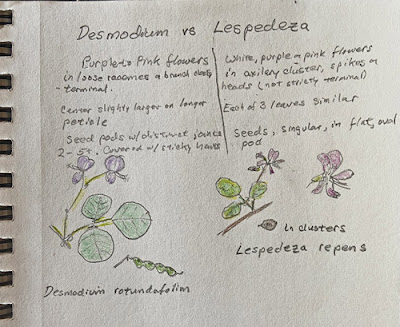For 2022 I have a smaller list of plants that I will be adding to my landscape than in years past. There are a number of reasons: I’m running out of space to tuck in new plants, I’m moving more seedlings of successful native species around, rather than purchasing new plants, and I am getting more selective about using regionally native species. However, I am not beyond adding a few species for decoration. New plants that I am adding are prairie willow (Salix humilis), creeping lespedeza (Lespedeza repens), a wild type smooth hydrangea (Hydrangea arborescens) and I’m trying winecups (Callirhoe involucrata) again in a less competitive environment.
I have been looking for native willows to replace the mounds of forsythia on my property. Willows bloom early in the spring, like forsythia. But unlike them, willows do provide a benefit to the native insects: early flowers for bees and as a host species for a number of insects. Early on I put in some native pussy willows (Salix discolor). These are doing well but mine tend to have a taller upright form (nearing 20’) rather than a more rounded shape that I was looking for. Prairie willow has the form I’ve been after, 4-7’ tall with a loose vase-shaped habit. It is also tolerant of drier conditions than most willows. I’ve got some on order, so we will see later this spring if my search is finally over. |
| Pussy willow blooms at about the same time as forsythia (shown here in the background). |
Another species that I have been trying to expand in my landscape is smooth hydrangea. Most of mine are the huge mophead type, most likely ‘Annabelle’. These grow really well with lots of flowers, but since most of these flowers are sterile, they offer little benefit to wildlife. Two years ago I planted planted some tiny pots of the ‘Haas Halo’ cultivar. These were highly rated in a recent study done at the Mt. Cuba Center. These have large lace cap flowers which consist of mostly small fertile flowers in the center surrounded by a ring of large sterile flowers. The plants grew to over 2’ tall last season, so I’m hoping I might see some flowers this year. To build on this diversity I ordered a wild-type smooth hydrangea to add to the mix. Wild-type plants usually have smaller flowers than the cultivars, but I’m hoping to see a benefit in the production of some seeds that could help the birds.
An ongoing project that I have is to find replacements for vinca, particularly in dry shade. I am expanding the scope to include a replacement for the yellow archangel (Lamiastrum galeobdolon) that is spreading in my pine woods. Last year I got some round leafed tick trefoil (Desmodium rotundifolium) for which I had been searching for 10 years (we’ll see how that has overwintered). It trails along the ground sporting three round leaflets on each stem. While examining catalogues I came across another trailing plant for dry shade, creeping lespedeza (Lespedeza repens). While not super attractive on its own, it may work nicely in a matrix planting.
The wine cups are an exception to my focus on regional natives. These are native more to the mid-west and southern plains, than to the east, but I became enamored with them ever since I saw them in a field in the Ft. Worth area. I was able to grow them in the Boston area and had them for awhile here in Maryland. The problem was that they were not able to compete with dense growth of asters, goldenrods, and Virginia creeper that surrounded them. This time I will plant them where they have a little more of their own space to get established.
 |
| The magenta flowers of wine cups are hard to miss. It has a sprawling habit and can form a ground cover where competing vegetation is sparse. |
As I mentioned above (and last year at this time) I will also be moving many native seedlings out of my vegetable garden, particularly Rudbeckia sp., Monarda fistulosa, Asclepias tuberosa, and Echinacea purpurea, and into the beds where I am fighting Japanese stiltgrass. I started that process last year. It’s too soon to see a difference, though some of the transplants appear to have overwintered. Their real value will be if they are able to reseed themselves and become self-sustaining.







